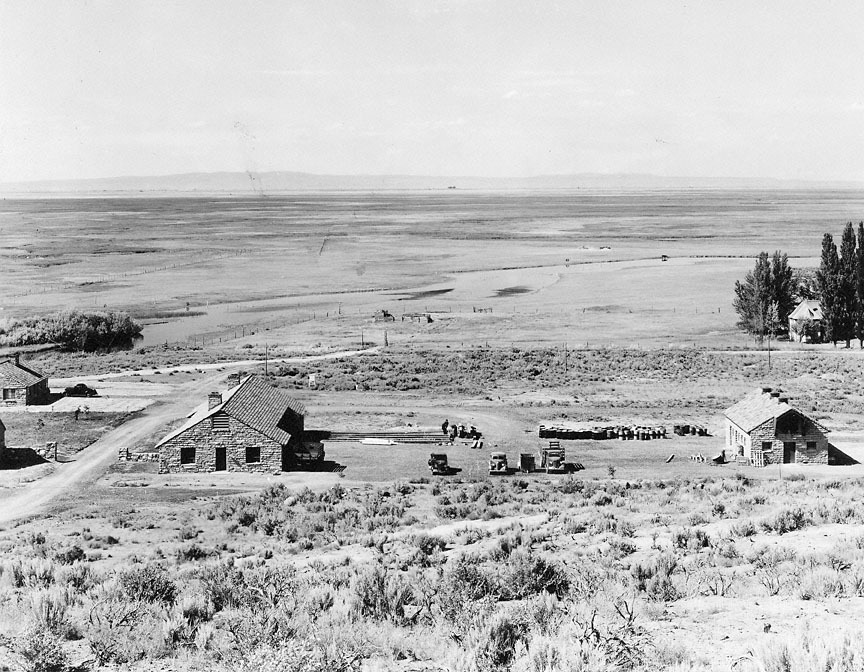- Catalog No. —
- OrHi 91097
- Date —
- 1937
- Era —
- 1921-1949 (Great Depression and World War II)
- Themes —
- Environment and Natural Resources, Government, Law, and Politics
- Credits —
- Oregon Historical Society
- Regions —
- Southeast
- Author —
- Ralph Gifford, Oregon State Highway Department
Malheur Migratory Bird Refuge, 1937
This photograph was taken in August 1937 by Ralph Gifford, a photographer for the Oregon State Highway Department. It shows the Malheur Migratory Bird Refuge, which was designated a National Wildlife Refuge in 1940.
President Theodore Roosevelt established the Malheur Bird Refuge in 1908 in order to stem the decline of migratory bird populations on the West Coast. William Finley, an Oregon conservationist and photographer, played a key role in convincing President Roosevelt to protect Malheur Lake for birds migrating along the Pacific Flyway, which stretches from Alaska to Mexico.
The refuge was barely established, however, before drainage efforts in the Malheur-Harney Lakes Basin threatened to destroy it. “Drainage fever” swept the nation during the first decades of the twentieth century. The drainage of wetlands opened up rich lands for agriculture and settlement. In an effort to encourage this effort, Oregon passed the Thompson Act in 1913, authorizing the drainage of wetlands and lakes. Four years later the state passed the Oregon District Irrigation Law, which allowed the formation of irrigation districts, the expenses of which were to be paid for with bonds.
Both private and public interests put forward a number of plans to drain the Malheur-Harney Lakes Basin in order to expand the area’s agricultural and ranching base. Although Finley and other conservationists vociferously protested these plans, which threatened to destroy migratory bird habitat, environmental historian Nancy Langston notes that conflicts over land and water rights were ultimately responsible for the failure of most of the drainage plans. However, a series of irrigation and drainage projects along the Silvies and Blitzen rivers withdrew most of the water from these two streams, leaving precious little for Malheur Lake. By 1934 the lake had gone dry, the result of a combination of irrigation withdrawals and a regional drought. Concerned about rapidly declining migratory bird populations, William Finley and his friend J. M. Darling, head of the U.S. Biological Survey, worked to expand the Malheur Refuge.
In 1934 the federal government acquired an additional 65,000 acres of land along the Blitzen River from the Chicago-based Swift Meat Packing Company. The Civilian Conservation Corps helped refuge staff build dams, dikes, canals, and other water control structures to restore the area’s lakes and marshes. By 1938, Malheur Lake had begun to refill, due in large part to these engineering efforts. Langston remarks that, “in a wonderful irony, the West’s grandest cattle empire became its grandest duck and wetland empire.”
Further Reading:
Langston, Nancy. Where Land & Water Meet: A Western Landscape Transformed. Seattle, Wash., 2003.
Littlefield, Carroll. Birds of the Malheur National Wildlife Refuge. Corvallis, Oreg., 1990.
Written by Cain Allen, © Oregon Historical Society, 2005.
